February 24, 2021
Kathleen
BY
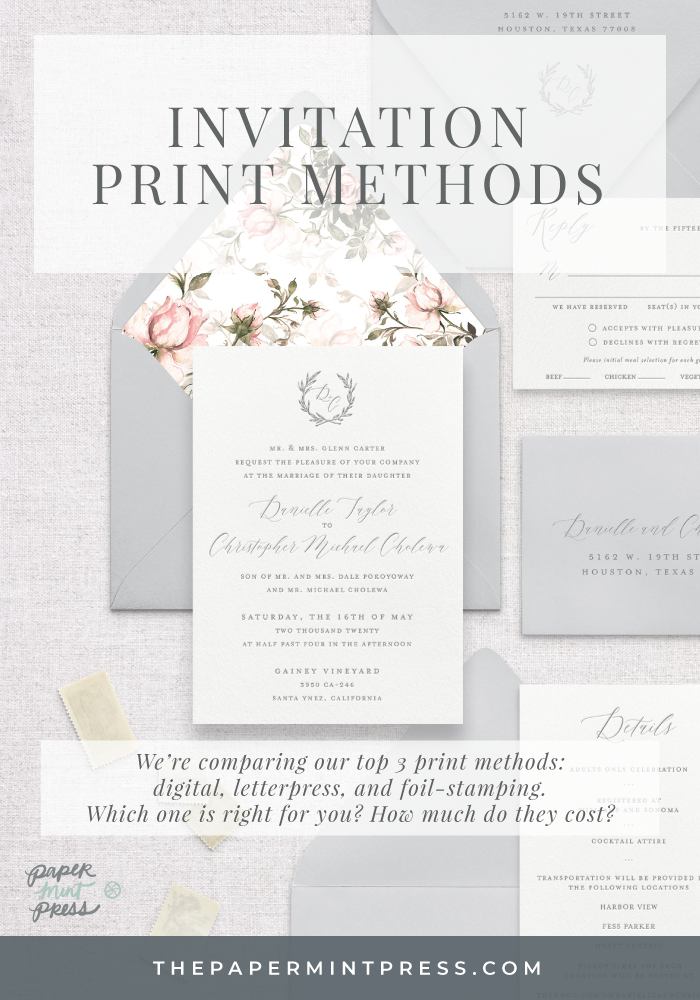
There are so many techniques and possibilities when it comes to printing your wedding invitations. We’re so proud to offer three different print methods to our clients: Digital, Letterpress, and Foil Stamping. All three methods are beautiful and have their own pros and cons. When couples fill out our Wedding Invitation Questionnaire, they are sometimes unsure about which printing method to choose. Each method has their own different price points, so what’s the difference between each of them? In this post, I’ll break down the common wedding invitation printing methods for you. My goal is to educate so you can confidently make a decision based on your wedding style and budget. Ready to learn? Let’s GO!
Digital or Flat Printing – $
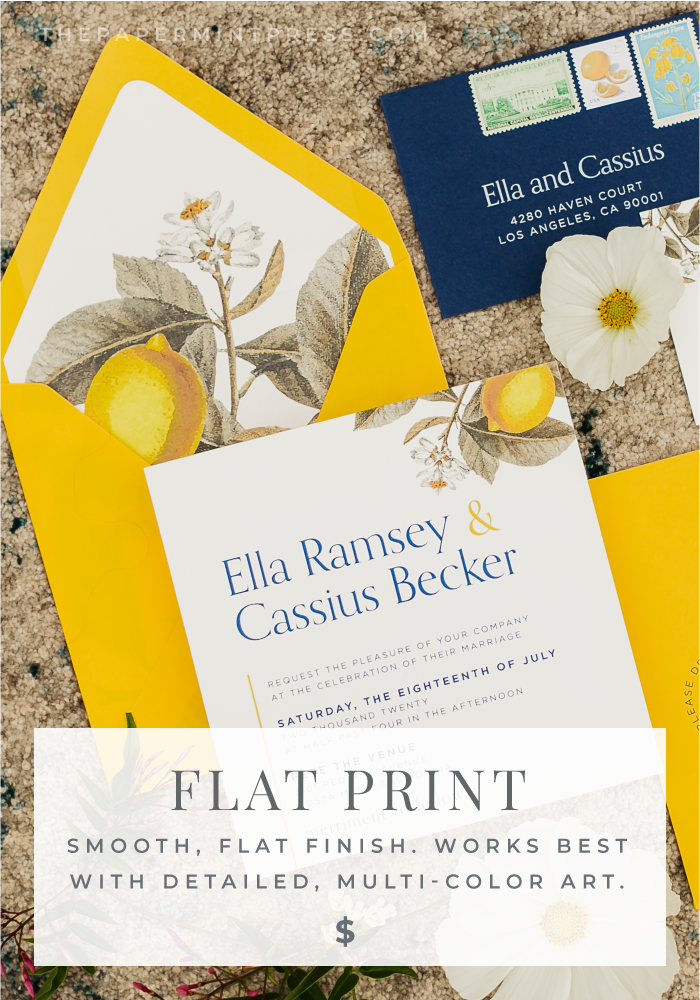
What is Digital/Flat printing? Digital or flat printing is the type of printing you’re probably most familiar with. Flat printing is a form of printing where ink (Cyan, Magenta, Yellow, and Black) is transferred to the paper using a digital image, resulting in a ‘flat’ finish. We offer flat printing to our clients who don’t have the budget or time for letterpress and foil, but still want a well-designed invitation suite from our collection.
What makes it special? There is no limitation to the number of colors can be printed.
Cost: It’s the most cost effective version between the three print methods we offer. Make no mistake about it, though. Just because it’s least expensive does not mean the quality suffers in any way. We have done meticulous research and offer only the highest quality paper. We can even print on stocks that are just as thick as our 2-ply cotton letterpress papers.
Limitations of Flat Printing: Well, flat printing is… flat. This type of printing is best for designs heavy on graphics – large floods of color, watercolor art, photographs, etc. Simple designs with a focus on typography can look great, but will lack the depth and textural element that only letterpress can achieve. Also, there’s no way to print a metallic finish via flat printing.
Who it’s for? Budget conscious couples or couples with a super tight deadline. It’s great for couples who aren’t 100% sure about their wedding plans since we can make last minute changes before printing.
Turnaround: Usually 2 weeks, but even sooner with a rush fee. Because it’s the quickest turnaround, this is the method we prefer for Day Of Wedding Accessories.
Letterpress Printing – $$
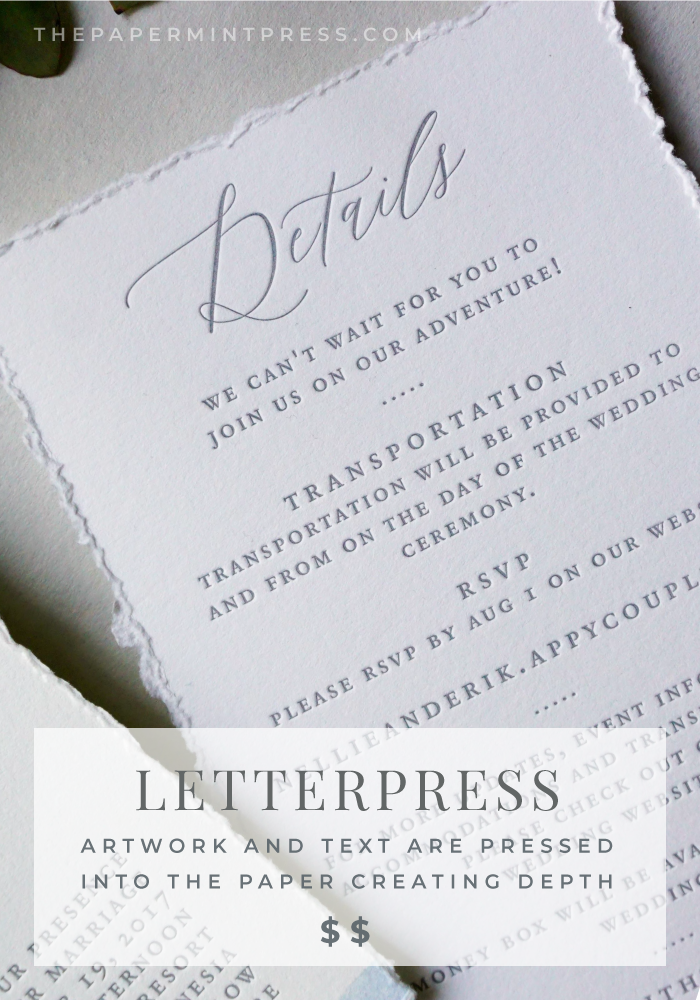
What is letterpress printing? Letterpress is a method of relief printing that utilizes a raised image (like a rubber stamp), that is pressed directly onto thick, soft cotton paper with a letterpress machine. This creates a beautiful “stamped in” effect that you can see and feel.
What makes it special? We’re biased, but in our opinion it’s one of the most beautiful print methods ever. The results are simply unmatched. The paper we print on is made of cotton, creating a deep, pillowy impression. Detailed artwork and thin fonts can print with crisp clarity even better than digital printing can. The results are truly striking, and you don’t even need a design that’s over-the-top. Simple script fonts or even block text instantly looks elevated in letterpress printing. In my opinion, you don’t even need more than one ink color to create a standout piece. When I come across a letterpress invitation, I can’t help but take a moment to inspect and appreciate the craftsmanship behind it.
Why is it so expensive? For one thing, letterpress machines simply aren’t made anymore. There’s a finite number of vintage machines available out there, and a handful of skilled printers who know how to operate them. In the past, designs were limited to wooden or metal type that a typesetter had to manually arrange on a chase (thing that holds the artwork onto the letterpress machine). Nowadays, we are able to combine images, text, and design elements onto photo-etched polymer plates. Many steps of the process are still done the old fashioned way, requiring a high level of craftsmanship and attention to detail. We still hand-mix the inks, manually register the position of the print, inspect each sheet as it goes through the press, and trim the final product by hand. In this way, modern technology melds with old machinery to create a hand-crafted, one-of-a-kind work of art. Simply put: it’s labor intensive and the materials (polymer plates, paper) cost more.
Limitations of Letterpress: While letterpress printing yields beautiful results, it is best used to print vector based designs. Letterpress printing is unable to capture the colors of a photograph the same way digital printing can, for example. So if you’re looking to print watercolor floral artwork on an invitation, I would recommend digital printing over letterpress. However, if you like the look of a detailed floral line drawing/sketch, letterpress is the perfect medium for that. It’s also quite a bit more expensive to run multiple colors since we can only print one ink color at a time. More colors = more plates = more setups/labor = more $.
Who is letterpress printing for? Anyone who loves the feel of luxe paper, who wants to create a memorable experience for their guests when they receive an invitation. Someone who wants their invitations to be a beautiful keepsake. Someone who appreciates the craftsmanship of handmade invitations made with an antique letterpress.
Turnaround: This really varies with each printer, but on average I’d say anywhere from 2 to 6 weeks. I typically like 2-4 weeks to print and assemble, if possible. Quicker turnarounds are possible with a rush fee.
Foil Stamping – $$$
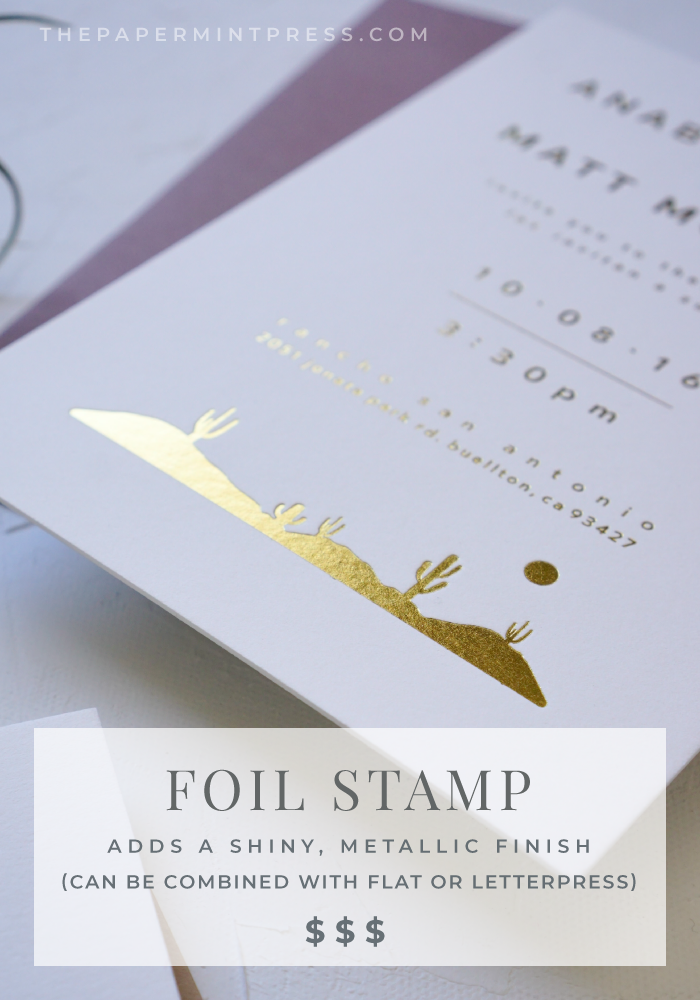
What is foil stamping? Traditional foil stamping is a similar process to letterpress printing, except it uses a combination of heat and pressure to stamp a thin metallic sheet over a custom metal die onto a sheet of paper. It requires a special press and custom made dies, usually made of copper, brass or magnesium.
What makes it special? It’s reflective and shiny! There is simply no way to print a metallic, shiny finish with traditional printer inks (I’ve tried – it just looks brown lol). Even metallized inks made for letterpress has a shimmery texture, but is not reflective or shiny the way metallic foil is. There are dozens of different foil colors available out there, but the most common around here are gold, rose gold, copper, silver, white, and holographic. This is ideal for highlighting design elements you want to stand out and can be combined with letterpress and flat printing. This method also works best for printing light colors on dark papers (ie. printing white text on black paper), because foils appear opaque on dark papers (whereas letterpress inks are transparent).
Why is it so expensive? Like letterpress printing, foil stamping requires special foil presses and custom dies that are generally expensive to make. The minimum cost for a custom foil die can range from $100-$300, depending on the size of your finished piece. This is in addition to the cost of paper and set-up fees. Like letterpress, this option makes sense for printing higher quantities, since the work involved in printing 1 piece vs. 100 pieces is the same.
Limitations of Foil Stamping: It takes a skilled pressman to print fine details and get crisp results in foil. Some printers have different capabilities and requirements, so if you’re a designer it’s best to ask your printer about a particular design before moving forward with an order. Generally, we recommend avoiding super thin details and loosening up the kerning between small letters. Like letterpress, you will also need vector based art, and multiple foil colors will cost you more in dies and setup fees.
Who it’s for: Couples who want to add some BLING to their invites!
Turnaround: We recommend 4-6 weeks to turnaround a custom foil job, especially if paired with other print methods.
How to choose the best invitation print method for your wedding
My advice is think about what is most important to you about your wedding invitations. What are your “musts” and why? For instance, when browsing invitations, what stands out to you the most? Is it the design? The luxurious feel of high end paper? The shiny finish?
If incorporating a specific design with lots of colors is something you envision over a fancy print method, then digital flat printing is a great option for you. You will be able to have a design created specially to tell your love story and print it economically, without sacrificing quality.
If you lean towards more understated and classic designs and appreciate the luxurious quality of specialty paper, letterpress might be the right fit for you. Many couples find that having their names in calligraphy or incorporating a monogram crest is a great way to personalize their invites, and would rather spend their budget towards a higher end print method and fancier paper. Plus, isn’t the idea of having your invites printed on an antique letterpress machine so charming?
If you just love how shiny metallic foil POPS out at you, then you can’t go wrong with foil stamping. There are so many fun foil colors to match your wedding style and you can always pair this option with digital or letterpress printing for a dynamic look. It may be the more expensive option, but there’s just something about the way that foil shimmers in the light that makes it so eye catching.
If you’re still not sure, start a conversation with us! We are happy to send sample packs with all three print methods so you can compare them for yourself. We can also recommend ways to incorporate these methods into your budget without compromising on quality. Hope this little guide helps break down the different processes a bit more!
READ MORE
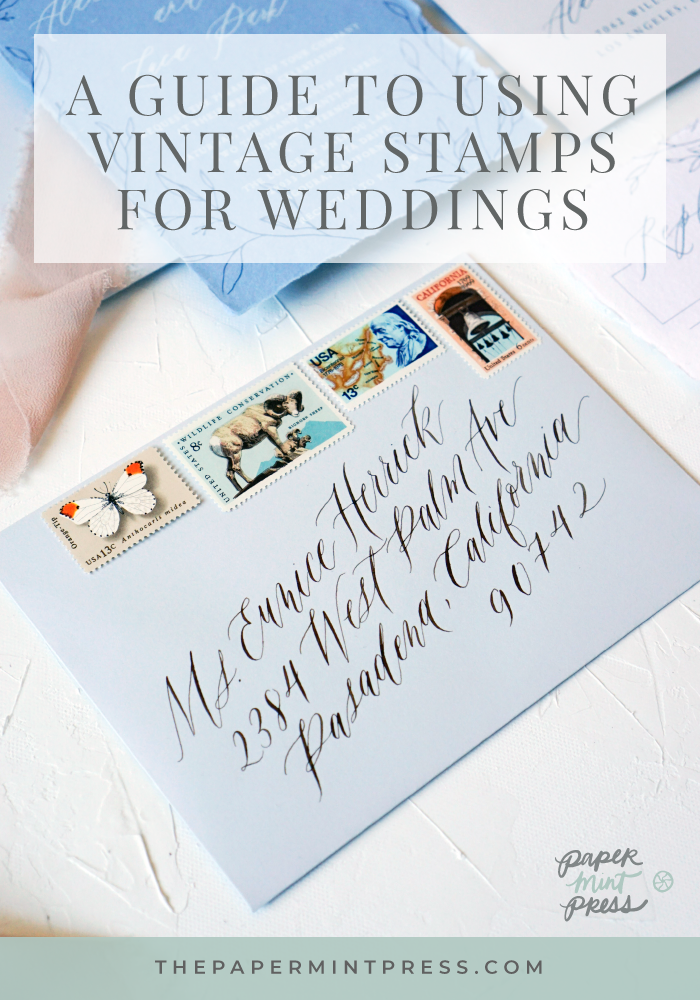
Vintage stamps add SO much charm and personality to a wedding invitation suite. I swoon every time I see a flatlay or a calligraphed envelope adorned with vintage postage stamps. Believe it or not, vintage postage requires a lot of research to calculate, source, curate, and assemble onto your envelopes. With so many moving parts […]
READ MORE
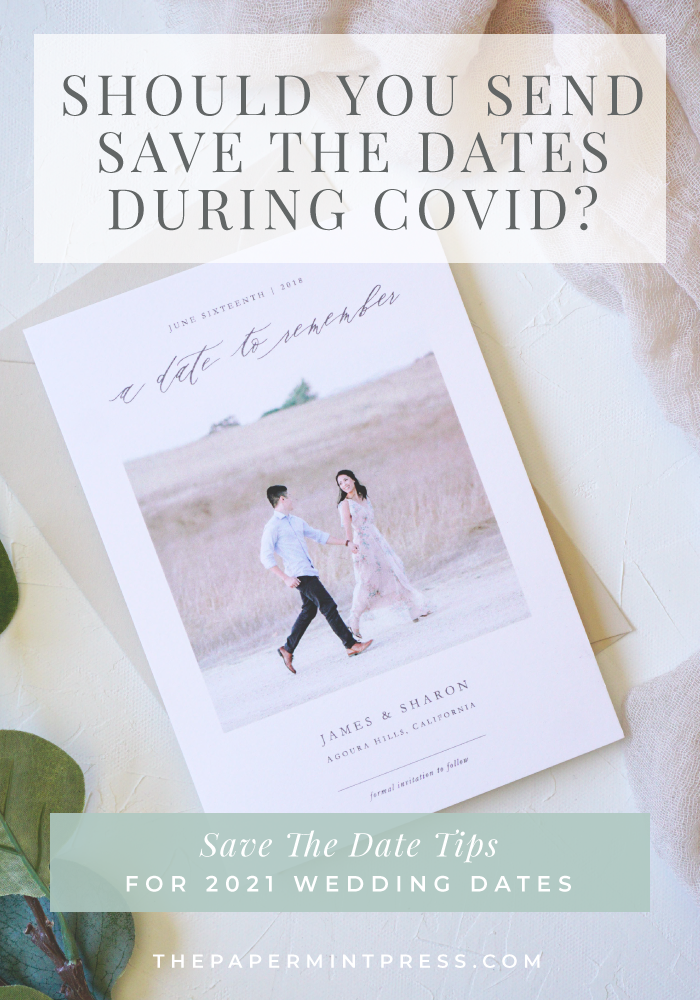
Oh, how COVID ruined many weddings and events that should’ve taken place in 2020. Trust me when I say I am hoping that 2021 is a much better year for weddings. If you’re planning to get married in 2021 and are wondering, “Should I send out Save The Dates?” you are not alone! If there’s […]
COMMENTS
0
COMMENTS
0
COMMENTS
0